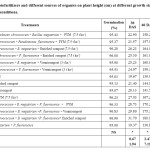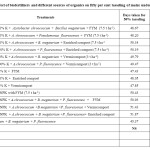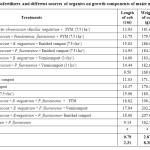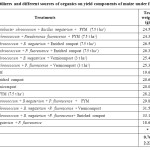Introduction
Maize is called “King of cereals” because of its productivity potential compared to any other cereal crop. Being an exhaustive crop, it has very high nutrient requirement and its productivity is closely depends on nutrient management system. Under the present trend of exploitive agriculture in India, inherent soil fertility can no longer be maintained on the sustainable basis. It is said that nutrient supplying capacity of soil declines steadily under continuous and intensive cropping system. The of optimum levels of N, P, K failed to maintain yield levels probably due to increasing secondary and micronutrient deficiencies and also unfavorable alterations in the physical and chemical properties of soil. Apart from the soil the fertility and productivity issues, use of chemical fertilizers is also becoming more and more difficult for the farmers due to their high costs and scarcity during peak season. On thus, increasing awareness is being created on the use of organics including biofertilizers which are the sources of macro, micro and secondary nutrients to sustain the soil fertility and productivity.
Organic matter improves water holding capacity of sandy soil and drainage in clayey soil. Organic manure provides nutrients for the soil micro-organisms, thus increases the activities of microbes in soil, which in turn help to convert unavailable plant nutrients into available form for plant growth promotion. The biofertilizers are found positive contribution to soil fertility, resulting in an increase in crop yield without causing any environmental, water or soil pollution hazards. Nitrogen fixing and Phosphorus solubilizing bacteria play an important role in nitrogen mobilization and phosphorus solubilization for the benefit of plant growth.
Material and Methods
Land Preparation
The land was ploughed twice with bullock drawn mould board plough followed by harrowing using cultivator and the entire plot was levelled with leveller and individual plots were made manually as per experimental plan.
Manures and Fertilizer Application and Treatment Imposition
Application of farm yard manure, enriched compost and vermicompost at the rate of 7.5 t ha-1, 7.5 t ha-1 and 3.0 t ha-1 respectively was applied to the plots two weeks prior to sowing as per the treatments. At the time of sowing 50 per cent of the specified nitrogen as basal dose, 75 per cent of recommended phosphorous and 100 per cent of recommended potassium was applied as per treatmental plan using urea, singlesuper phosphate andmuriate of potash respectively. The remaining 50 per cent nitrogen was top dressed at the rate of 25 per cent each at 25 days after sowing and at tasseling initiation stage.After 10 days of chemical fertilizers application the microbial inoculants of Azotobacterchroococcum, Bacillus megaterium (PSB) and Pseudomonas fluorescence (PGPR) at the rate of 10 kg ha-1 was applied as soil application.
Sowing and Plant Protection Practices
Before sowing of crop, furrows were opened at 60 cm interval with the help of hand hoe. Two seeds were dibbled at 30 cm spacing on 20th August 2011. Recommended nutrients and microbial inoculants were applied separately at the base of row and covered with soil. A week after emergence, seedlings were thinned to maintain two plants per hill. Final thinning was attended two weeks after the emergence to maintain only one healthy seedling per hill. Hand weeding was done at 30 days after sowing and one time inter – cultivation by chipkunte was carried at 20 days after sowing to keep all the plots uniformly weed free throughout the crop growth period. Earthing up of soil was also made at 30 days after sowing to have good support and aeration to the plant roots.
Irrigation
Protective irrigation was provided to the crop.Proper care was taken to avoid movement of fertilizers from one plot to another during irrigation. All plots were irrigated immediately after sowing for uniform germination.Further irrigation was given at 5 days interval during crop growth. Irrigation was stopped one week prior to harvest of the crop.
Biometric Observations
Pre-Harvest Observation
All plant growth observations were recorded treatment wise in the net plot area at monthly interval, starting from 30 days after sowing to till harvest. Five plants were tagged at random in each plot and observations were recorded. Germination (%),Plant height (cm) and Days taken for 50% tasselling.

Harvesting and Threshing
The crop was harvested on 10th December 2011. Five plants were randomly selected in each net plot area for recording yield attributing parameters like Length of cob, Weight of cob.
The crop in the net plot was harvested and threshed separately. Grain and straw were sun dried and Grain weight per cob, Number of grains per cob, Test weight (g/ 100 seed), Grain yield per plant and Grain yield per ha (q ha-1)was recorded as per treatment and converted to yield in quintal per hectare.Grain number per cob was calculated from the grain weight per cob and the corresponding thousand grain weight.

Total Dry Matter at Harvest (g plant-1)
The five randomly selected plants were used to record the dry matter production at harvest. The sampled plants were separated into leaves, stem (including sheath). These samples were dried in an hot air oven at 60 ±10C until a constant weight is achieved and dry weight was recorded.
Result and Discussion
The results obtained in the investigation on “Comparative efficiency of organics and biofertilizers on growth and yield of maize are discussed below. The germination was not significantly influenced by treatments. However, maximum germination was recorded (96.90%) with the application of recommended dose of NPK + A. chroococcum + B. megaterium+ P. fluorescence + enriched compost(T13).This is due to better soil condition with application of organics and biofertilizers. This is in conformity with the results of Amruthesh et al., (2003) and Hameeda et al., (2008) who observed such increased germination due to biofertilizers application and showed in Fig 1.
Among the different growth parameters, significant increase in the plant height was observed till the end of crop growth period. The treatment (T13)receivingrecommended dose of NPK + A. chroococcum + B. megaterium+ P. fluorescence + enriched compostrecorded maximum plant height at 30, 60, 90 days after sowing and at harvest (31.77, 180.93, 186.07 and 188.13 cm). Increased plant height may be due to the application of recommended dose of NPK and microbial consortia of nitrogen fixer, phosphate solubilizer and PGPR bacterium with nutrient rich organic source like enriched compost. The increase in growth of maize could be attributed to the enhanced nutrient use efficiency in the presence of organic fertilizer. Many research studies have showed that the composted organic materials release nutrients slowly and may reduce the leaching losses, particularly N (Nevens and Reheul, 2003 and Naveed et al., 2008)and showed in table 1.
 |
Table 1: Effect of biofertilizers and different sources of organics on plant height (cm) at different growth stages of maize under field conditions. Click here to View table |
The number of days taken for fifty per cent tasseling by maize did not differed significantly due to treatment effects. However, maximum days taken for fifty per cent tasseling was recorded (51.87 days) with recommended dose of NPK + A. chroococcum + B. megaterium+ P. fluorescence+ enriched compost(T13)and showed in table 2.
 |
Table 2: Effect of biofertilizers and different sources of organics on fifty per cent tasseling of maize under field conditions. Click here to View table |
Influence of Biofertilizers and Different Sources of Organics on Yield of Maize
The treatment (T13) havingrecommended dose of NPK + A. chroococcum + B. megaterium+ P. fluorescence + enriched compostresulted in the production of significantly higher cob length of maize(18.60 cm), grain weight per cob (106.23 g) and number of grains per cob (424.37). This might be due to the positive effect of organic fertilizer and biofertilizers on better root development which resulted in more nutrient uptake. These microorganisms also produce vitamins and plant growth promoting substances for the betterment of plant growth. Organic manures not only slowly release nutrients slowly but also prevent the losses of leaching (Arshadet al. 2004, Anup Das et al., 2010).
The cob weight obtained (207.63 g) was also maximum in (T13) treatment having recommended dose of NPK + A. chroococcum + B. megaterium+ P. fluorescence + enriched compost. This could be attributed to the combined application of biofertilizers and organic manures which enhance the nutrient uptake. These results are in accordance with the work of (Shaharoona et al., 2006) who reported such increase in yield attributes of maize due to Pseudomonas inoculation and showed in table 3.
 |
Table 3: Effect of biofertilizers and different sources of organics on growth components of maize under field conditions. Click here to View table |
The treatment (T13) havingrecommended dose of NPK + A. chroococcum + B. megaterium+ P. fluorescence + enriched compostrecorded the highest test weight (33.10 g), grain yield per plant (158.93 g) and grain yield per ha (54.53 q)compared to other treatments. This might be due to more availability of nutrients from compost and beneficial effects accruded due to Azotobacter and phosphate solubilizing bacteria (PSB) inoculation which provide nitrogen and phosphorus to plant growth. It may also be due to production of amino acids, vitamins and growth promoting substances like indole acetic acid and gibberellic acid secreted by these introduced beneficial microorganisms which resulted in enhanced nutrient uptake, translocation and synthesis of photosynthate assimilates which resulted increased plant growth characters and in obtaining economically profitable yield (Singh et al., 2006 and Suke et al., 2011) showed in table 4.
 |
Table 4: Effect of biofertilizers and different sources of organics on yield components of maize under field conditions. |
Total dry matter at harvest was maximum in (T13) recommended dose of NPK + A. chroococcum + B. megaterium+ P. fluorescence+ enriched compost(375.80 g). This may be due to the ability of biofertilizers to transport major nutrients like N and P besides secreting plant growth promoting substances such as IAA, gibberellins and abscisic acid. An organic acid obtained from organic manures has lead to increase in soil acidity and consequently convert insoluble forms of phosphorus into soluble ones (Wani et al. 2007 and Abou-el-seoud and Abdel-megeed, 2012) and showed in table 2.
Conclusion
The findings of this study have clearly showed that combined application of Azotobacter chroococcum, Bacillus megaterium and Pseudomonas fluorescence along with recommended dose of NPK and enriched compost has resulted in obtaining highest plant growth, crop yields and dry matter production.
References
- ABOU-EL-SEOUD, I.I. AND ABDEL-MEGEED, A., 2012, Impact of rock materials and biofertilizations on P and K availability for maize (Zea maize) under calcareous soil conditions. Saudi J. of Biolo.Sci.,19: 55–63.
CrossRef - AMRUTHESH, K.N., RAJ, S.N., KIRAN, B., SHETTY, H.S. AND REDDY, M.S., 2003, Growth promotion by plant growthpromoting rhizobacteria in some economically important crop plants. In: Sixth International PGPR Workshop, 5–10 October, Calicut, India, 97–103.
- ANUP DAS, GOUR, C. M., DHARMENDRA, P. P., PROBIR KUMAR, G., SHISHOMVANAO, N. AND PANKAJ, B., 2010, Productivity, nutrient uptake and postharvest soil fertility in lowland rice as influenced by composts made from locally available plant biomass.Arch. of Agron. Soil Sci.,56 (6):671–680.
CrossRef - ARSHAD, M., KHALID, A., MAHMOOD, M. H. AND ZAHIR, Z.A., 2004, Potentiality of nitrogen and L-tryptophan enriched compost for improving growth and yield of hybrid maize. Pak. J. Agric. Sci.,41:16-24.
- HAMEEDA, B., HARINI,G.,RUPELA,O.P.,WANI S.P. AND GOPALA REDDY, 2008, Growth promotion of maize by phosphate solubilizing bacteria isolated from composts and macrofauna. Microbiological Research.,163:234—242.
CrossRef - NEVENS, F. AND REHEUL. D., 2003, The application of vegetable, fruit and garden waste (VFG) compost in addition to cattle slurry in a silage maize monoculture: nitrogen availability and use. Europ. J. Agron., 19: 189-203.
CrossRef - NAVEED, M., KHALID,M.,JONES,D.L.,AHMAD, R. AND ZAHIR, Z.A.,2008, Relative efficacy of Pseudomonas spp., containing ACC-deaminase for improving growth and yield of maize (Zea mays L.) in the presence of organic fertilizer.Pak. J. Bot.,40(3): 1243-1251.
- SHAHAROONA, B., ARSHAD,M.,ZAHIR, Z.A.,AND KHALID, A., 2006, Performance of Pseudomonas spp. containing ACC-deaminase for improving growth and yield of maize (Zea mays L.) in the presence of nitrogenous fertilizer.Soil Biol. Biochem.,38: 2971-2975.
CrossRef - SINGH, Y., SINGH, C.S., SINGH, T.K. AND SINGH, J.P., 2006, Effect of fortified and unfortified rice-straw compost with NPK fertilizers on productivity, nutrient uptake and economics of rice (Oryza sativa). Indian J. Agron.,51(4):297–300.
- SUKE, S.N., DEOTALE, R.D., PRIYANKA HIRADEVE, MITALI DEOGIRKAR AND SORTE,S.N.,2011, Effect of nutrients and biofertilizers of chemical and biochemical parameters of maize (Zea mays L.).J. Soil and Crops,21(1):107-112.
- WANI, P.A., KHAN, M.S. AND ZAIDI, A., 2007, Synergistic effects of the inoculation with nitrogen-fixing and phosphate-solubilizing rhizobacteria on the performance of field-grown chickpea.J. Plant Nut. Soil Sci.,170: 283–287.
